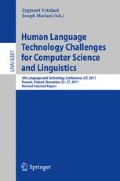Abstract
We describe first attempts to textually record non-linear elements of Polish Sign Language utterances. The effects of those experiments will be applied in the Thetos translator. We use the Thel language to textually express signed utterances. Currently our attention is focused on methods used in the PSL for manifesting emotions as well as on pauses done while signing. To detect non-linear elements we examine a predicate-argument (semantic) representation of the input utterance, and analyze syntactic relations existing between elements of input syntactic groups. This process engages specific rules that refer to features of syntactic groups and relations. We have identified a number of partial rules and found a method for building respective fragments of the output utterance. In the paper we show some of them. Additionally, we describe solutions used in the Thel words dictionary for mapping spoken language vocabulary to its sign language counterpart, which is definitely poorer.
Access this chapter
Tax calculation will be finalised at checkout
Purchases are for personal use only
Notes
- 1.
Current form of interpretation is: \(=\) MAŁY \(=\) WIEJSKI DOMEK. (\(=\) little \(=\) rural house.), where the character ‘\(=\)’ means a neutral face expression. However after first experiments we tend to give using the character ’\(=\)’ up because it brings nothing in animation whereas it may augment the pause between words, what is an undesired effect.
- 2.
Let’s remind that the verb group structure in the SGGP grammar is different than it is established in the traditional linguistics. For example, object can never be a verb group component.
References
Fabisiak, S.: Sign languages and corpus-based linguistics. Jȩzyk Polski XC 4–5, 338–345 (2010). (in Polish)
Gladky, A.V.: Natural Language Syntactic Structures in Automated Communication Systems. Nauka, Moskva (1975). (in Russian)
Kulików, S.: Implementation of the linguistic analysis server for THETOS, the text into sign language translation system. Stud. Inform. 24(3(55)), 171–178 (2003). (in Polish)
Lubiński, M., Suszczańska, N.: POLMORPH, polish language morphological analysis tool. In: Proceedings of the 19th IASTED International Conference APPLIED INFORMATICS - AI’2001, Innsbruck, Austria pp. 84–89 (2001)
Marcinkowska, A.: Metaphors and metonims as a denotation process in Polish Sign Language. M.Sc.Thesis under the direction of M. Świdziński, Division of Computer Linguistics, Polish Language Institute. Warszawa (2009). (in Polish)
Mikulska, D.: Non-manual elements in polish sign language. In: Świdziński, M., Gałkowski, T. (eds.) Studies on Lingual Competence and Communication of the Deaf, pp. 79–97. Zakład Graficzny UW, Warszawa (2003). (in Polish)
Mrozik, M.: Wstȩpne uwagi o morfologii polskiego jȩzyka migowego (PJM). In: Świdziński, M., Gałkowski, T. (eds.) Studies on Lingual Competence and Communication of the Deaf, pp. 59–77. Zakład Graficzny UW, Warszawa (2003). (in Polish)
Romaniuk, J., Suszczańska, N., Szmal, P.: An attempt to automatically translate into the sign language emotionally colored textual utterances. Speech Lang. Technol. 12/13, 85–96 (2009/2010)
Romaniuk, J., Suszczańska, N., Szmal, P.: Semantic analyzer in the Thetos-3 system. In: Vetulani, Z. (ed.) LTC 2009. LNCS (LNAI), vol. 6562, pp. 234–244. Springer, Heidelberg (2011)
Rutkowski, P., Łacheta, J., Marganiec, B.: The Polish Sign Language (PJM) corpus project. In: SIGN 6 – 6th International Conference of Sign Language Users. Calangute, Goa, India (2013)
Suszczańska, N.: SG-grammar of Polish Syntax. In: Conference Speech Analysis, Synthesis and Recognition in Technology, Linguistics and Medicine, pp. 113–117, Kraków (2005). (in Polish)
Suszczańska, N., Szmal, P., Simiński, K.: The deep Parser for Polish. In: Vetulani, Z., Uszkoreit, H. (eds.) LTC 2007. LNCS (LNAI), vol. 5603, pp. 205–217. Springer, Heidelberg (2009)
Szczepankowski, B.: The Hearingless - Deaf - Deaf-mute. Chance equalization. Warszawa (1999). (in Polish)
Szmal, P., et al.: Translation of Polish texts into the sign language. Research project no. 8 T11C 007 17 final report. Silesian University of Technology, Gliwice (2001). (in Polish)
Szmal, P., et al.: Aiding hearing impaired people with a computer generation of the sign language. Research project no. 4 T11C 024 24 final report. Silesian University of Technology, Gliwice (2005). (in Polish)
Świdziński, M., Gałkowski, T. (eds.): Studies on Lingual Competence and Communication of the Deaf. Zakład Graficzny UW, Warszawa (2003). (in Polish)
Twardowska, E. (ed.): State of research on the Polish Sign Language. PZG Łódź (2008). (in Polish)
Vetulani, Z.: Man-machine communication. In: Computer Modeling of Linguistic Competence. Exit, Warszawa (2004). (in Polish)
Zajadacz, A.: The PSL Travel Dictionary. Verification in PSL: Kowalska, M., Kowalski, S., UAM internal report, Poznań (2010). (in Polish)
Author information
Authors and Affiliations
Corresponding author
Editor information
Editors and Affiliations
Rights and permissions
Copyright information
© 2014 Springer International Publishing Switzerland
About this paper
Cite this paper
Romaniuk, J., Suszczańska, N., Szmal, P. (2014). Thel, a Language for Utterance Generation in the Thetos System. In: Vetulani, Z., Mariani, J. (eds) Human Language Technology Challenges for Computer Science and Linguistics. LTC 2011. Lecture Notes in Computer Science(), vol 8387. Springer, Cham. https://doi.org/10.1007/978-3-319-08958-4_11
Download citation
DOI: https://doi.org/10.1007/978-3-319-08958-4_11
Published:
Publisher Name: Springer, Cham
Print ISBN: 978-3-319-08957-7
Online ISBN: 978-3-319-08958-4
eBook Packages: Computer ScienceComputer Science (R0)

